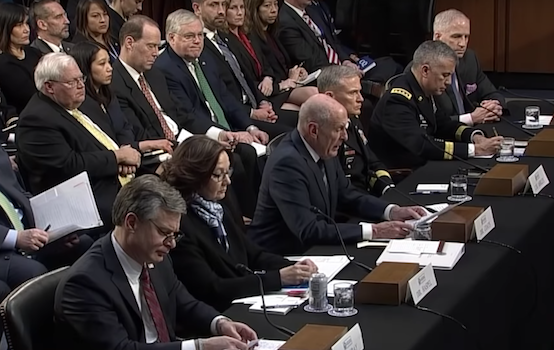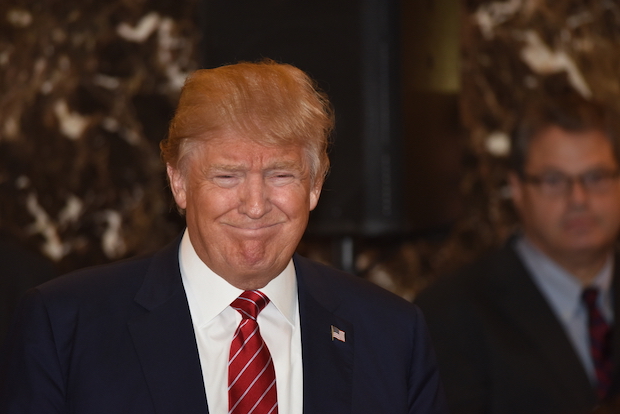Their leadership got Iraq wrong. Now they’re making the same mistakes all over again.

Earlier this week, the collective leadership of the United States intelligence community briefed Congress on the Worldwide Threat Assessment Report.
In doing so, they provided testimony that seemed to contradict virtually every aspect of President Donald Trump’s foreign policy, including the decision to withdraw troops from Syria and Afghanistan, the threat posed by Iran, North Korean denuclearization, and improving relations with Russia.
The president, in typical fashion, lashed out, criticizing the intelligence community’s collective analysis, which predictably elicited criticism from both Democrats and Republicans. They accused him of undermining public confidence in the pronouncements of the intelligence agencies and damaging national security.
In this case, Trump is right and his detractors are wrong.
The current crop of national intelligence chiefs are cut from the same cloth as their predecessors. They are careerists who have risen to the top not through their analytical or operational talents, but through their willingness to conform to a system that is designed not to challenge conventional thinking—especially when such thinking sustains policies that have been given the imprimatur of the entrenched establishment.
Rare is the politician who is well enough versed in the minutia of history and foreign affairs to generate original thinking—or bold enough to challenge the status quo on the grounds that it isn’t working.
Richard Nixon and George H.W. Bush were among the original thinkers, leaders who opened relations with communist China and oversaw the peaceful collapse of the Soviet Union, respectively.
Among those who challenge the status quo is Donald Trump, a political maverick who, rightly or wrongly, has sought to challenge the conventional dogma in ways no previous politician ever has.
There is no better illustration of the intellectual corruption of the intelligence community than its performance in the lead-up to the 2003 invasion of Iraq.
The current dean of the intelligence establishment, the former director of national intelligence, James Clapper, illustrates perfectly the slavish impulse to conform.
In his book Facts and Fears: Hard Truths from a Life in Intelligence, Clapper writes, “We heard that Vice President Cheney was pushing the Pentagon for intelligence on Iraqi weapons of mass destruction, and then the order came down to NIMA [the National Imagery and Mapping Agency, which Clapper headed at the time] to find the WMD sites [original emphasis]. We set to work, analyzing imagery to eventually identify, with varying degrees of confidence, more than 950 sites where we assessed there might be WMDs or a WMD connection. We drew on all of NIMA’s skill sets…and it was all wrong.”
One of the most damning indictments of the intellectual vacuum within the intelligence community comes from the Senate Intelligence Committee’s examination of the failures that led to the erroneous conclusions over Iraq’s WMDs.
That report found that not once did the intelligence community question the underlying assumption that Iraq retained weapons of mass destruction, despite no hard intelligence sustaining that assumption. Instead, every assessment started by assuming that Iraq possessed those weapons.
The same mindset permeates the intelligence community’s analysis today. To understand why, consider the current crop of intelligence community leaders.
Dan Coats, the director of national intelligence, served as U.S. ambassador to Germany during the build-up to the Iraq war, and was the point man for selling the war to the Germans.
Gina Haspel, director of the CIA, is a career operations officer who served as the deputy group chief of the Counterterrorism Center from 2001 to 2003, a time when that organization was promoting fictitious ties between Iraq and al-Qaeda.
While serving as associate assistant deputy U.S. attorney, FBI Director Christopher Wray helped oversee the Department of Justice’s response to the 2001 terror attacks on the United States, and as such was involved in the effort that falsely linked al-Qaeda to Iraq.
In the lead-up to the invasion of Iraq, the current director of the Defense Intelligence Agency, Lieutenant General Robert Ashley, commanded the Intelligence Squadron of the Army Office of Military Support, the unclassified title of the top-secret Intelligence Support Activity, or ISA.
ISA played a critical role in helping build the database used by American commandos and the CIA in their futile search for WMD in Iraq.
In the critical years before the 2003 invasion, the current director of the NSA, Lieutenant General Paul Nakasone, served as an intelligence planner for the Joint Chiefs of Staff, where he would have been ideally positioned to question many of the premises that were used to justify the war.
In the time between the invasion of Iraq in 2003 and their joint testimony before Congress, the leadership of the intelligence community participated in virtually every intelligence-based operation and activity undertaken by the United States, including torture, illegal eavesdropping, and supporting the failed military interventions in Libya, Afghanistan, Iraq, and Syria.
They also played an important role in building the current analysis used to shape threat estimates regarding North Korea, Iran, China, and Russia.

The president has lambasted this group and he is right to do so. On Iran, the president calls the intelligence community leaders “passive and naïve.”
While they rightly point out that Iran is today operating in conformity with the nuclear deal, they are silent on earlier intelligence estimates that maintained that Iran had an active nuclear weapons program up until 2003, and that aspects of this program were continued until at least 2007.
Under President Barack Obama, the United States entered into the Iran nuclear agreement without adequately addressing these estimates, especially in the face of continued Iranian denials that such a program ever existed.
Trump has picked up on this contradictory analysis. He’s noted logically that if Iran had a nuclear weapons program that it’s refused to acknowledge, then it must be holding this capability in reserve until it can act on it—which would be once the sunset clauses of the nuclear agreement expire and Tehran is free to enrich uranium without constraint.
Trump is wrong—there never was a nuclear weapons program in Iran—but he is right in pointing out the inconsistencies in the intelligence community’s position.
The same holds true on the other policy issues where the intelligence community took issue with Trump’s actions. The exaggeration of the ISIS threat in Syria and Iraq today is little more than a smokescreen to justify continued military deployment there.
The assessment of North Korea’s nuclear intent seems to mirror past analytical errors regarding Iraq by failing to consider that the North Koreans might be serious about denuclearization.
And the collective fixation on Moscow’s bad intentions seems premised on notions of Russian global ascendency that ignore American provocations of Russia, including massive interference in its domestic political affairs and the expansion of NATO despite assurances to the contrary.
When it comes to foreign policy, Donald Trump is no Richard Nixon or George H.W. Bush.
But neither is he a Bill Clinton, George W. Bush or Barack Obama, caught in a series of foreign policy traps thanks to a lack of vision and their collective willingness to accept at face value a picture painted by an intelligence community conditioned only to see threats.
Trump is right to call them out. They should be informing him on foreign policy and national security matters, not dictating or critiquing his policies. The track record of these so-called professionals is not impressive. They would do well to heed the president’s exhortation that they “go back to school.”
Scott Ritter is a former Marine Corps intelligence officer who served in the former Soviet Union implementing arms control treaties, in the Persian Gulf during Operation Desert Storm, and in Iraq overseeing the disarmament of WMD. He is the author of Dealbreaker: Donald Trump and the Unmaking of the Iran Nuclear Deal (2018) by Clarity Press.
This article was originally published by “The American Conservative“
The 21st Century
